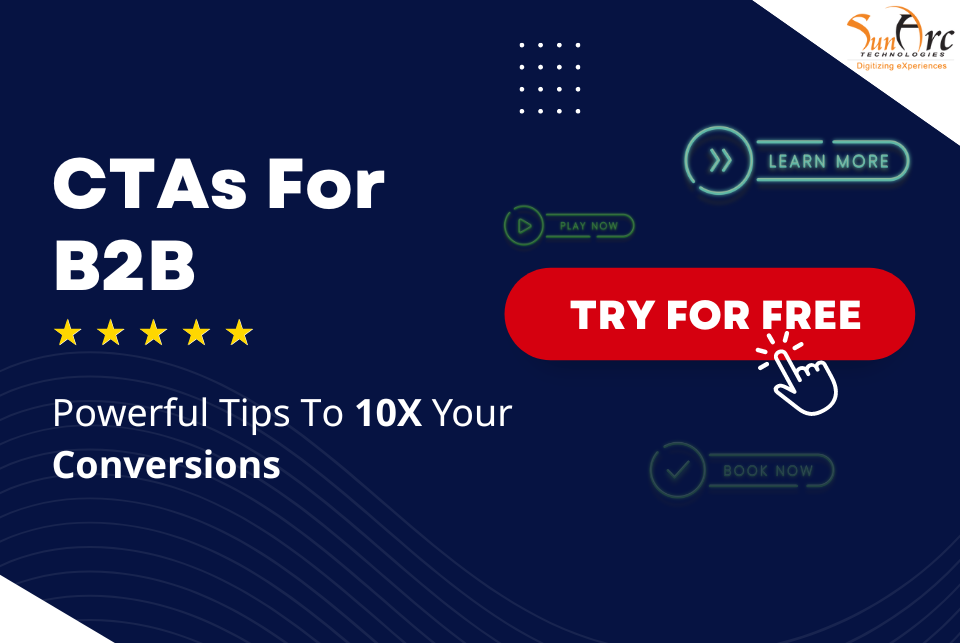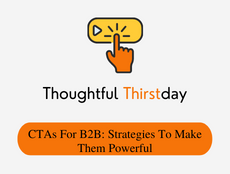“Click Here”, “Download”, and “Submit” Clicking on these CTAs is far away, even no one will pay attention to these Call-to-actions (CTAs).
However, the first step of every business is to grab the audience’s attention. And after getting attention and capturing the audiences’ interest, CTAs play a crucial role in turning potential leads into paying clients.

When it comes to B2B CTAs, prospects have longer buying cycles, they take more time to become familiar with your brand, and they go deeper into every detail to check out how your product or services will affect their business.
So the B2B CTAs should be created in a way that will lead them one step at a time, from the top of the funnel to the bottom.
Although B2B CTAs are different from the remaining CTAS, where the rest of the marketing CTAS work on Convince and Convert Immediately Mode, the B2B CTAs work on Convinces and Converts but not Immediately.
In B2B you need to encourage your prospect to click on a specific testimonial so that they can go further a step in the funnel you’ve created and obtain all of the information necessary for their business.
After setting up all these things in your mind, you need to move towards designing B2B CTAs.
Let’s check out how to make B2B CTAs more powerful and attention-grabbing.
How to Create the Best B2B CTAs?
Your CTA should have:
- Striking content copy
- Eye-catching and memorable design
- Perfect placement
- Constantly improving
1. Striking Content Copy
Possibly your most effective strategy for getting visitors to click on your CTAs is the copy of the content. Whenever you design the CTAs, you should utilize those words that convey a sense of importance, urgency and trust. Keep your content copy alluring and concise. Keep in mind that a long CTA is unlikely to stimulate a response.
Never overpromise anything in your CTA’s wordings. It is obvious that you will always want people to click on your CTA, but on the other hand, you will also have to ensure that whenever the visitors click on that CTA and land on your desired website page or newsletter or service section, they should not be disappointed.
It’s hard to design a fantastic CTA without some amazing content behind it. Make sure the wording on your CTA appropriately reflects the product being advertised. Along with this be creative with the words’ selection. “Download Now” and “submit” is old and boring, use some fresh and engaging pickup lines like “Get My Free trial”, and “Sign-up for Weekly Goodies”.
2. Eye-catching and Memorable Design
The design defines your personality, the most crucial design concern should simply be: how can I make it stand out? A colour that matches the background of your website or blog pages should be avoided.
It’s crucial to avoid the urge to include CTAs into the entire look of your website since you want them to stand out rather than merely blend in as another component. To draw visitors’ attention, try adding colourful accents to your CTA.
The most widely used colours are typically red, green, orange, and blue. From there, you might want to decide based on what works best for your website.
Here are the great colour choices, that big brands are incorporating:
- Blue – favoured by businesses in the finance and insurance industries.
- Red – Best for creating urgency to buy among the audience.
- Green – Best for Add to Cart activities.
- Purple – Extremely popular with ladies.
- Black – makes one feel luxurious.
3. Perfect Placement
Hit the right spot
Your CTAs should be placed strategically, since choosing the right spot can significantly enhance click-through rates. CTA buttons should be placed “above the fold” on landing pages or at the top of a web page so that users can see them without having to scroll.
To break up the content in your blog, experiment with utilising both in-line and picture CTAs at various places. Not everyone may read to the bottom of a lengthy blog post, so consider including a CTA halfway down to draw readers in.
However, don’t use too many CTAs on a single page. Because every time a reader consumes the content of your blog and a CTA appears constantly in front of him, he will leave your website after being frustrated by it.
You can place your CTAs:
- At the top of the web page
- At the end of the web page
- In the middle of a blog
- In email marketing copy
- In the sidebar
4. Constantly Improving
Creating CTAs should be a continuous activity that necessitates regular evaluation. Even effective CTAs can rapidly lose their appeal, so keep a close eye on views, click-through rates, and submissions. If performance appears to be declining, try a different CTA. One of the easiest methods to determine what works well is through A/B testing.
Additionally, think about the measures that define success. These measures might vary depending on where your content is in the sales funnel. Views and click-throughs are helpful indicators if your content is about raising awareness.
if your content is intended for readers who are further along the customer journey, your CTAs must trigger actions that are more specific and you must use more complex analytics to monitor audience behaviour.
So continuous improvements based on ongoing signals are necessary to get the most out of your CTAs.
Final Thoughts
Today’s customers are smart, and to reach them out, you need brilliant CTAs.
B2B CTAs are more specific, customer-centric, business-centric, and focused on building long-lasting relationships. The B2B customers need time to consider your offerings, as they deeply study everything before taking a final decision.
So trust factor plays an important role here. If you want to create B2B CTAs, it’s your responsibility to use your CTAs to lead visitors through your funnel rather than persuade them right away.
If you are facing trouble with the right B2B CTAs, contact us today. Our professionals will assist you in making the CTA that hit your customers’ minds differently.

